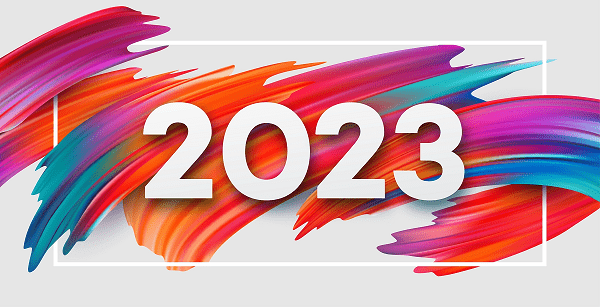
From its inception in the 15th and 16th centuries until the 1900s, philanthropy was a conservative venture. Then, between 1930 and 1980, philanthropy was truly redefined, as, according to the National Philanthropic Trust, it was “reacting to and changing with the major events of the century,” such as WWII, the Korean War, and the Vietnam War. Today, grantmakers are better informed and significantly more engaged in solving problems and addressing issues facing our world. Just as our fast-paced society moves from trend to trend, whether in the realms of entertainment or politics, the interests and focus of philanthropists also shift quickly. The difference is that in the field of philanthropy the trends are deeper and more sustained, and will hopefully build a better world for us all.
The trends discussed below are all relevant to your grantseeking in 2023. Several of the larger trends in grantmaking center around building movements, developing leaders, shifting cultures, creating an inclusive economy, and defending democracy. In addition, grantmakers of every ilk—government and non-government, global and national, regional family and community foundations—are engaged in place-based philanthropy as well as collective impact and true diversity. Finally, in the U.S and Canadian federal and state/provincial government realm, there are many valuable resources to reference that may impact your grantseeking.
Building a Movement
Movement building, as defined by The Solutions Project, is, “organizing and motivating people to work towards a collective vision or cause that is important for a community.” When you think “movement” you think “big”, such as Black Lives Matter or Schools Strike for Climate. But that isn’t always the case. A movement can be as simple as your community deciding to take back its streets or a group of bikers determined to create bike lanes in their community. Of course, it can also be larger and more encompassing, such as a national or even global movement to meet the U.N. climate change goals.
The trend here is simply that funders are interested in movements, especially those that effect local change. (See place-based philanthropy below.) There has been a growing awareness of and interest in this type of focused change over the past few years. To review a few case studies, check out “Funding Movement Building: Bay Area Approaches,” published by Justice Funders.
Developing Leaders
Grantmakers are eager to encourage the development of new leaders that truly reflect the community they serve. Simply having community voices heard via committees or by sitting on the board doesn’t cut it any more: grantmakers want to see leaders that reflect the community the organization serves. Developing leaders that reflect the community may require coaching, not only face to face but also using new communication methods. Dare I say, think gamification? According to Training Industry, leadership training via gamification requires a specific and targeted behavior: “When used in conjunction with a leadership competency model . . . gamification can help integrate knowledge with performance.”
Having a specific plan for developing leadership is critical, especially one that takes advantage of current technology. You can gather some ideas about the types of technology available to use in the article, “A Learning Tech Roundup: 7 Types of Software and Tools to Improve Training.” Even though it is focused on corporate training, the article hits on some interesting ways to engage learners. Training Industry also offers a free ebook, Expert Perspectives on E-Learning Delivery, which is available for download at the bottom of the article.

Shifting Cultures
A culture shift is basically changing beliefs, behaviors, and outcomes. Now, much like movements, this shift can be large or small, or somewhere in between. For example, a small cultural shift may be internal to your organization: simply getting individual staff members to think differently, look at your work in a new way, or address your mission with a different perspective. For a great article on how to change your internal organizational culture, read “How to Create an Inspired Nonprofit Culture”. It provides some provocative steps to embrace if you were, for example, writing a capacity building proposal.
Many grantmakers are becoming more and more interested in broader cultural change, but it is difficult to understand how this might work. Simplicable offers a bit of guidance here by providing 15 examples of culture change. This is an older article, but still relevant today, and helps illustrate what we mean by shifting culture.
Developing an Inclusive Economy
According to the DC Fiscal Policy Institute, “In an inclusive economy, economic growth leads to shared prosperity that allows every resident economic security, resources to build wealth, and opportunity to live to their fullest,” while the Thomson Reuters Foundation states “Economies are only truly inclusive when they are equitable, participatory and sustainable, and when they respect and preserve the environment around us.”
Racial equity walks hand in hand with economic equity. More and more, grantmakers will be looking closely at grant proposals focused on developing an inclusive economy to make sure that there is recognition of, and specific tactics for addressing, racial inequities. The NAACP website offers lots of information that may be helpful in considering how to integrate this into your community and economic development projects.
There is another way of looking at this trend. In one of Project Equity’s recent emails, they defined an inclusive economy as “workers who go from feeling powerless to becoming powerful worker-owners with a voice in not only the day-to-day activities, but the governance and operations of their workplace thanks to employee ownership. That voice is a fundamental part of building an inclusive economy.” This statement seems to resonate with many funders across the U.S. and Canada. Project Equity has launched an Employee Ownership Accelerator Campaign with the goal of two million employee owners by 2026. This is perhaps a response to the U.N.’s Sustainable Development Goal #8, Decent Work and Economic Growth for all. To get a better sense of what Project Equity is trying to accomplish, and how their mission might fit into your grantseeking in 2023, read through their 2021 Impact Snapshot. In this snapshot, they articulate the basic steps toward realizing employee ownership. For a deeper dive into this topic, there is more information on their website, including case studies. For those of you working in the area of community and economic development, social justice, and worker’s rights, this is a solid reference document.
To get a true sense of how you might weave this topic, which is of high interest to grantmakers, into your work, read “The Five Characteristics of an Inclusive Economy” published by the Rockefeller Foundation.
Defending Democracy
There is definitely an emerging philanthropic trend focusing on defending democracy, not only in the U.S. but also abroad. Most organizations won’t have defending democracy as part of their projects—at least not as a main goal. However, we can all address this trend by making sure we incorporate democratic approaches into all of our work. This could be as simple as making sure underserved communities are aware of and have the opportunity to share their concerns around issues that concern them, such as community and economic development projects.
You can find some interesting and helpful guidance around this topic at the Protect Democracy website.

Place-Based Philanthropy
More and more grantmakers will focus on placed-based giving in 2023. The Milken Institute defines placed-based philanthropy as “an approach that targets a specific location—be it a neighborhood, municipality, or even multiple counties—upon which to focus charitable resources and make a transformative impact. It goes beyond supporting a community foundation or funding unrelated efforts in a contained space.”
By using this approach, funders can help to address complexities and root causes of a challenge or problem, employ comprehensive approaches to dealing with the issues, and promote more lasting change within the community.
How might this work for your organization? Let’s take a problem as complex as climate change. Addressing the many issues that lead to changes in our climate at the local or regional level may yield substantial, measurable results. A partnership between local governments, nonprofits, businesses, and philanthropists might actually make a difference not only in reducing global warming but also in preparing your community to face the many challenges global warming will create in your geographic region. Your job is to demonstrate in your grant proposal that the funder’s investment at the local level can really effect transformative change.
Below is a case study of placed-based philanthropy at its best. Focused on the Buhl Foundation and One Northside (Pittsburgh, PA), this study was included by the Milken Institute in their field guide for philanthropists who are considering place-based grantmaking:
Founded in 1928, the Buhl Foundation is Pittsburgh’s first multipurpose philanthropy. For nearly a decade, the foundation supported city-wide efforts in education, youth development, human services, and economic and community development. Beginning in 2013, the foundation has chosen to prioritize its grantmaking to a subset of Pittsburgh called Northside. Concentrating its focus at this multi-neighborhood level enhances the foundation’s ability to make a noticeable difference in those residents’ lives, and it has also mobilized a grassroots movement, called One Northside, for the community to further support long-term, sustainable change for the area. One notable area of impact includes its HOPE Diversion Program, a pilot initiative working to divert young, low-level victimless crime offenders out of the criminal justice system; in late 2019, 94 percent of the program participants had not re-offended.
If you believe this approach would work well for your organization, and that there are partners to be had in the local community, then start by learning as much as you can about place-based philanthropy and engaging your regional funders in a discussion.

Collective Impact/Collective Action
According to the Collective Impact Forum, collective impact is defined as a structured partnership that brings together government, business, nonprofits, and philanthropy to tackle complex social issues. By uniting key players from across sectors, this structured partnership model empowers these groups to commit to a shared agenda and measurement system that will better position them to solve a social problem.
The Forum explains the five conditions that have to be met in order to result in collective impact. If you are writing a proposal and want to base your project’s impact on this model, consider these five partnership conditions:
- a common agenda;
- shared measurements (ultra important to the overall success of this model);
- mutually reinforcing activities;
- continuous communications amongst the partners; and,
- strong leadership or backbone.
This is a significant trend, and while it mirrors public/private partnerships, it seems to have a lot more clout. To explore this concept further, there is a curated set of foundational tools on the Forum’s website. You begin by taking a self-assessment.
True Diversity
To get a sense of what true diversity is, let’s take a look at Philanthropy Roundtable’s explanation:
By embracing the richest possible diversity of unique traits, backgrounds, perspectives and experiences within each individual, True Diversity offers a way for organizations to most effectively advance their missions, help communities in need and make every person feel they truly belong—and matter.
This framework represents a powerful way for charitable organizations to honor the things that make us all human and harness their power to develop individualized pathways to opportunity that serve the whole person. True Diversity provides the freedom and flexibility these organizations need to pursue ideas and strategies that empower those on the ground and achieve better outcomes. In short, it’s the best way to both advance the most effective solutions and fully achieve the benefits of diversity in a complex world.
True diversity also includes fair chance hiring. According to RSF Social Finance, this is a growing trend, most often promoted as a way to help formerly incarcerated people find work after prison, breaking the cycle of poverty and recidivism. However, more and more it includes people with disabilities, homeless individuals, veterans or spouses of military, and people from underserved communities.
As you write proposals that reflect this trend, consider the five principles true diversity espouses, including:
- value each individual;
- advance your organization’s mission;
- seek diverse perspectives on how to address an issue;
- embrace conversations that discuss and debate the issue(s); and,
- cultivate empowerment by fostering a sense of agency.
You can learn more about the five principles encompassed in true diversity via this article.

U.S. Federal Government Focus
If you plan on applying for U.S. federal funds, you may want to browse the Budget of the U.S. Government Fiscal Year 2023 in order to align with the Federal government’s priorities.
For example, the Department of Commerce has been tasked with strengthening the nation’s supply chains through domestic manufacturing. If you are a social enterprise, this is the time for you to approach larger businesses and government agencies to see if the products you offer might help bolster the existing supply chain. There is $125 million set aside to, “make America’s small and medium manufacturers more competitive and to ensure that the future is made in all of America by all of America’s workers.”
Understanding these priorities will help you craft competitive grant requests. In addition, mirroring the language in this document when writing your proposals will help demonstrate that your project can help the department, whether it’s the Department of Agriculture, Department of Education, Department of Commerce, etc., meet their 2023 objectives.
Canadian Federal Government Focus
The 2023 budget information hasn’t yet been released by the Canadian government, but their Fall Economic Statement 2022 is available for review. You can also review the 2022 budget here. Again, you want to read through those sections most relevant to your work, and mirror much of the language used when writing and submitting grant requests.
U.S. State Focus and Trends
To get a sense of what is happening at the state level nationwide, browse the website of the National Governors Association (NGA). It provides some enlightenment and context on what is important to governors across the country, which can again be useful when putting together your grant proposals. For example, if you are writing a proposal around safety issues for your school or school system, knowing that your governor is on the working group addressing school and community safety could be very beneficial.
In fact, following the school shooting in Uvalde, Texas, former NGA Chair, Arkansas governor Asa Hutchinson, and current Chair, New Jersey governor Phil Murphy, wrote a letter to President Biden informing him of the establishment of NGA’s Governors’ Bipartisan Working Group on School and Community Safety. Knowing this fact and quoting from this letter would provide you with a strong opening to a grant request.
Within the NGA, there are several task forces covering a variety of issues. These different task forces provide a glimpse of the trends happening at the state government level. For example, the NGA Community Renewal Task Force page enumerates their current priorities. Again, if your work falls within one of these priorities, and you are seeking funding for your project via the state government, you may want to reference these priorities, or even quote your governor if he or she is on this task force.
The NGA website also links to all of the governor's websites. Once you are on your governor’s website, you can easily navigate to your state's budget.
Canadian Provincial Focus and Trends
The website of the Council of the Federation, made up of Canada’s provincial and territorial premiers, can provide you with a good idea of what the provincial governments are supporting. Their key initiatives are “aimed at addressing present and future challenges facing the federation, in order to better meet the changing needs of Canadians.”
The website’s publications page offers insights into various focus areas and activities, such as the National Healthcare Survey published in February 2022. If healthcare is part of your organization’s mission, quoting from this survey could greatly strengthen your funding requests. Although this website isn’t a very dynamic collection of information, it does provide some insight and will help you as you move forward with developing your requests at the provincial level.
From this website, you can go directly to the websites of each Canadian province to get a sense of what they will be focusing on in 2023. These websites are much more dynamic! For example, if you go to the Manitoba website, you can easily access the 2022 Budget. Reviewing Manitoba's Poverty Reduction Strategy will give you a sense of their investment commitment for 2023. This initiative was launched in 2019, and, as you read through their current undertakings, it becomes clear that they are looking for real system change.
In Summary
Bottom line? By keeping abreast of the latest grantmaking trends, you will find that you incorporate many of these concepts and ideas into your programs and grant requests, making your proposals more competitive and the eventual outcome of your program or project successful.
To close with, here are two additional resources to bookmark to keep up on top trends in philanthropy:
- Pew Research Center offers a treasure trove of information you can use in your grant requests, including many articles and publications that serve both Canada and the U.S.
- Center for Effective Philanthropy offers reports, case studies, and guides on a variety of topics to do with philanthropy. You can search by topic and type of publication on this page.